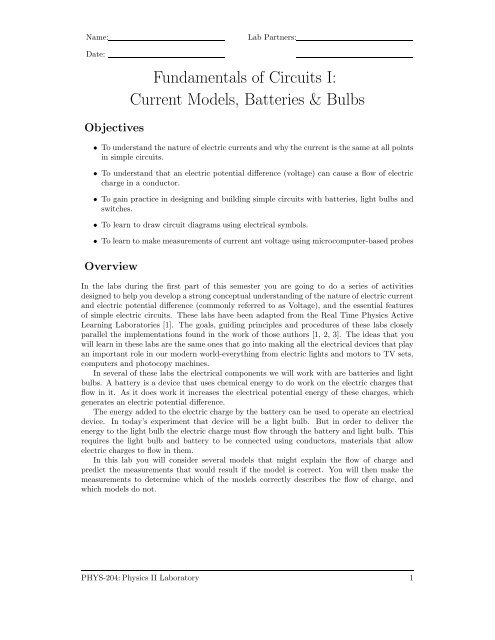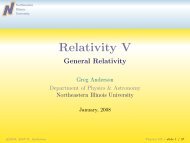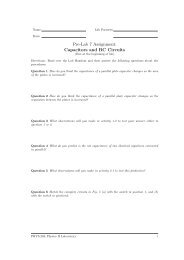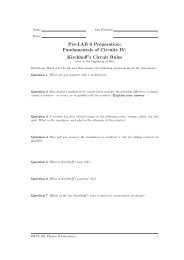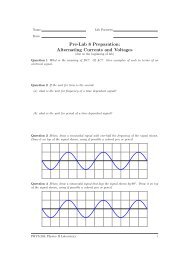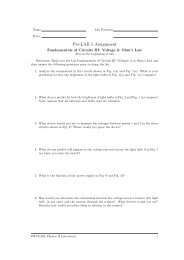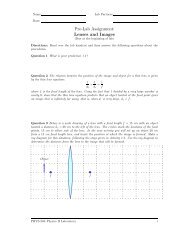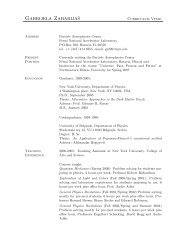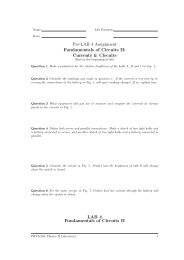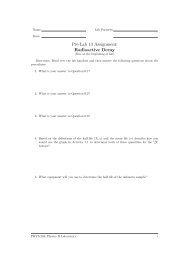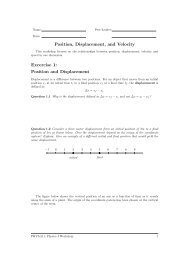Fundamentals of Circuits I: Current Models, Batteries & Bulbs
Fundamentals of Circuits I: Current Models, Batteries & Bulbs
Fundamentals of Circuits I: Current Models, Batteries & Bulbs
Create successful ePaper yourself
Turn your PDF publications into a flip-book with our unique Google optimized e-Paper software.
Name:<br />
Date:<br />
Lab Partners:<br />
<strong>Fundamentals</strong> <strong>of</strong> <strong>Circuits</strong> I:<br />
<strong>Current</strong> <strong>Models</strong>, <strong>Batteries</strong> & <strong>Bulbs</strong><br />
Objectives<br />
• To understand the nature <strong>of</strong> electric currents and why the current is the same at all points<br />
in simple circuits.<br />
• To understand that an electric potential difference (voltage) can cause a flow <strong>of</strong> electric<br />
charge in a conductor.<br />
• To gain practice in designing and building simple circuits with batteries, light bulbs and<br />
switches.<br />
• To learn to draw circuit diagrams using electrical symbols.<br />
• To learn to make measurements <strong>of</strong> current ant voltage using microcomputer-based probes<br />
Overview<br />
In the labs during the first part <strong>of</strong> this semester you are going to do a series <strong>of</strong> activities<br />
designed to help you develop a strong conceptual understanding <strong>of</strong> the nature <strong>of</strong> electric current<br />
and electric potential difference (commonly referred to as Voltage), and the essential features<br />
<strong>of</strong> simple electric circuits. These labs have been adapted from the Real Time Physics Active<br />
Learning Laboratories [1]. The goals, guiding principles and procedures <strong>of</strong> these labs closely<br />
parallel the implementations found in the work <strong>of</strong> those authors [1, 2, 3]. The ideas that you<br />
will learn in these labs are the same ones that go into making all the electrical devices that play<br />
an important role in our modern world-everything from electric lights and motors to TV sets,<br />
computers and photocopy machines.<br />
In several <strong>of</strong> these labs the electrical components we will work with are batteries and light<br />
bulbs. A battery is a device that uses chemical energy to do work on the electric charges that<br />
flow in it. As it does work it increases the electrical potential energy <strong>of</strong> these charges, which<br />
generates an electric potential difference.<br />
The energy added to the electric charge by the battery can be used to operate an electrical<br />
device. In today’s experiment that device will be a light bulb. But in order to deliver the<br />
energy to the light bulb the electric charge must flow through the battery and light bulb. This<br />
requires the light bulb and battery to be connected using conductors, materials that allow<br />
electric charges to flow in them.<br />
In this lab you will consider several models that might explain the flow <strong>of</strong> charge and<br />
predict the measurements that would result if the model is correct. You will then make the<br />
measurements to determine which <strong>of</strong> the models correctly describes the flow <strong>of</strong> charge, and<br />
which models do not.<br />
PHYS-204: Physics II Laboratory 1


